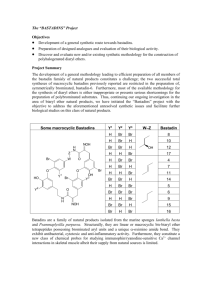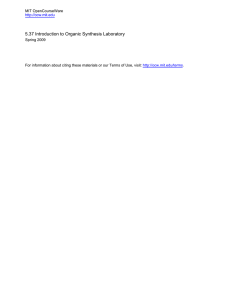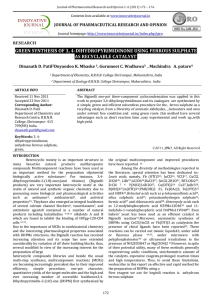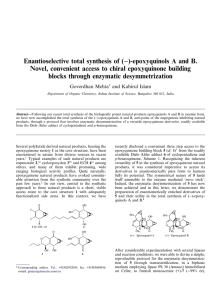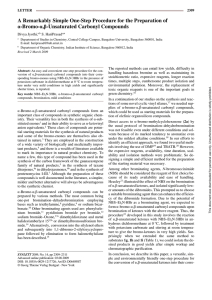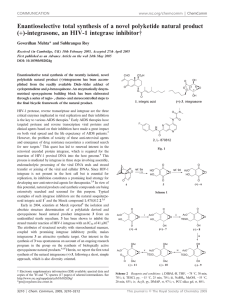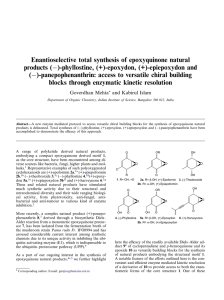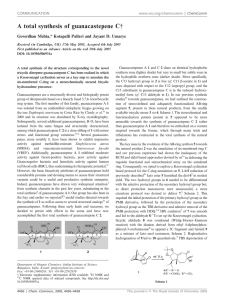5.37 Introduction to Organic Synthesis Laboratory
advertisement
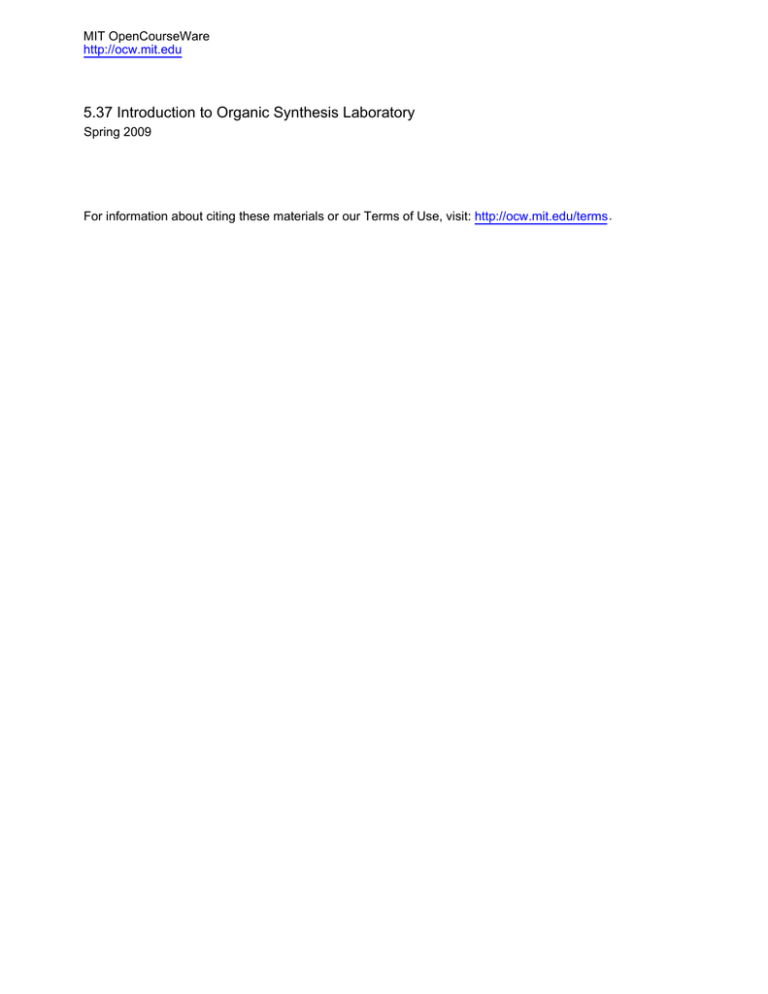
MIT OpenCourseWare http://ocw.mit.edu 5.37 Introduction to Organic Synthesis Laboratory Spring 2009 For information about citing these materials or our Terms of Use, visit: http://ocw.mit.edu/terms. Chemistry 5.37 Module 7: Introduction to Organic Synthesis Catalytic Asymmetric Cycloadditions Instructions for Discussion Section of Final Report One of our goals in Module 7 is to become acquainted with current research frontiers in the field of synthetic organic chemistry. Toward that end, a section of the Discussion section of your final report should be devoted to a critical review of a publication describing an approach to asymmetric DielsAlder reactions. This short assignment will give you an opportunity to think in further detail about the concepts we discussed in the series of 5.37 lectures and will also help you to consolidate your understanding of the principles of asymmetric Diels-Alder reactions introduced in Module 7. Your “mini-review” need only be 2-3 pages in length and should provide a brief “profile” of a specific asymmetric Diels-Alder strategy different from the ones we discussed in the 5.37 lectures. You may choose a strategy based on a chiral auxiliary approach, or one based on catalysis. Your mini-review should include a concise description of the specific method (illustrated with one or more ChemDraw schemes), specific examples of the method in action (either as ChemDraw schemes or as a Table), and some critical remarks highlighting the strengths and limitations of this particular strategy. If space permits and you are interested, you may also wish to comment on the mechanistic basis for the stereocontrol associated with the method. Your mini-review should be based on a single publication, but in some cases you may need to read some prior papers from the same research group for background. You are free to choose any strategy that interests you, provided that it is not one that we discussed in lecture. Listed below are several interesting papers that you may choose from, or you may select another strategy that you identify from literature searches (such as a Citation search on one of these methods or one of the papers discussed in lecture). This assignment is intended for you to work on individually. I prefer that each student choose a different paper to base their mini-review on, but in some cases I may permit two students to write (separately) on one of the more important papers. To ensure minimal overlap, please inform me of which paper you would like to write on and receive “approval” from me before May 12. Please send me an email indicating your first choice and I will let you know if that paper is still available or not (first come, first served). If you wish, feel free to send me a list with a second and even third choice as backups in case your first choice is already taken. Please do not hesitate to let me know if you have any questions about the assignment or about asymmetric Diels-Alder chemistry. I also welcome your comments and suggestions concerning the experiment, the lectures, and any other aspect of URIECA. Chiral Auxiliary Approaches Hydroxy Ketones Terpene Sultam Oxazolidiones Pantolactone Pantolactone Sugar Pantolactone Sultam Done Masamune Oppolzer Oppolzer Evans Helmchen Arai Gras Yamamoto Oppolzer Sibi J. Org. Chem. 1983, 48, 4441 Helv. Chim. Acta. 1985, 68, 2100 Tetrahedron 1986, 42, 4035 J. Am. Chem. Soc. 1988, 110, 1238 Tetrahedron Lett. 1989, 30, 5595 Tetrahedron Lett. 1991, 32, 4557 Tetrahedron Lett. 1991, 32, 5529 Synlett 1993, 638 Tetrahedron Lett. 1994, 35, 3509 Tetrahedron Lett. 1995, 36, 8965 Catalytic Asymmetric Diels-Alder Strategies TADDOL Oxazaborolidinone BINOL BINOL Bis-Oxazolines Bis-Oxazolines Bis-Oxazolines TADDOL Oxazaborolidinone Oxazaborolidinone PyBOX Oxazaborolidinone Silacycle Triflyl Phosphoramide Diamine Oxazaborolidine Narasaka Corey Kobayashi Kobayashi Ghosh Senanayake Evans Hirama Corey Corey Desimoni Yamamoto Leighton Yamamoto Maruoka Yamamoto J. Am. Chem. Soc. 1989, 111, 5340 J. Am. Chem. Soc. 1991, 113, 8966 J. Org. Chem. 1994, 59, 3758 J. Org. Chem. 1994, 116, 4083 Tetrahedron: Asymmetry 1998, 9, 3687 Synthesis 1998, 937 J. Am. Chem. Soc. 1999, 121, 7582 Tetrahedron Lett. 2000, 41, 6669 J. Am. Chem. Soc. 2002, 124, 3808 J. Am. Chem. Soc. 2003, 125, 6388 J. Org. Chem. 2003, 681, 7862 Angew. Chem. Int. Ed. 2005, 44, 1484 Tetrahedron 2006, 62, 11397 J. Am. Chem. Soc. 2006, 128, 9626 Org. Lett. 2006, 8, 2687 J. Am. Chem. Soc. 2007, 129, 9536




